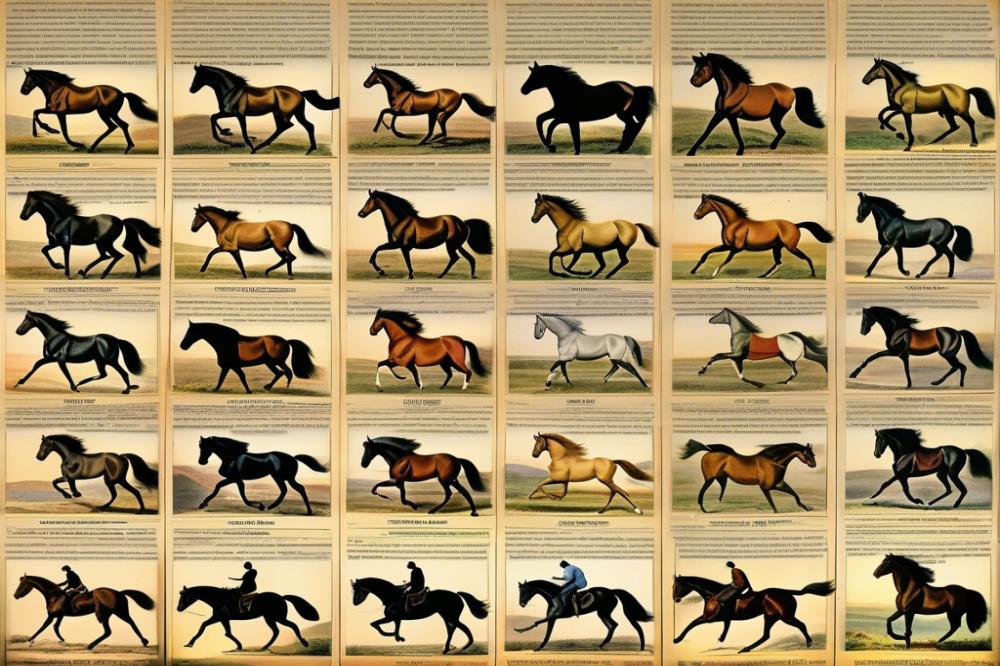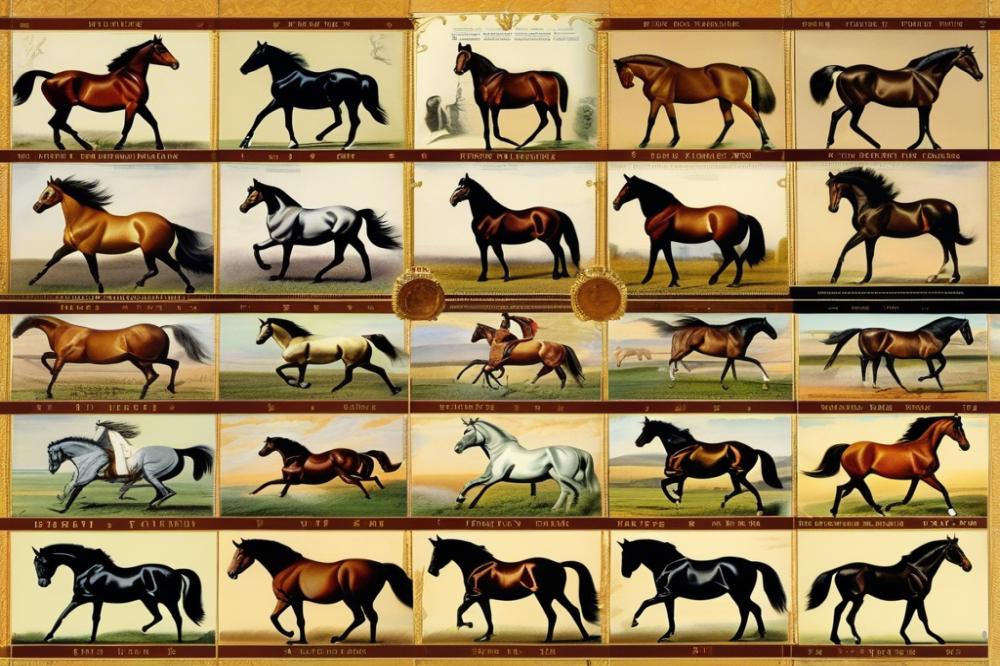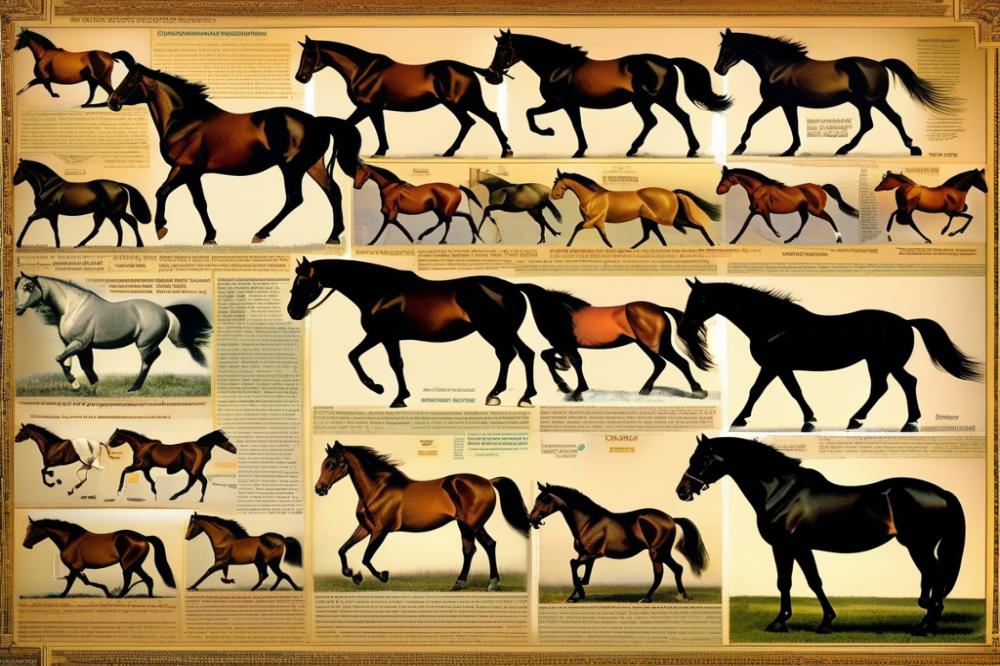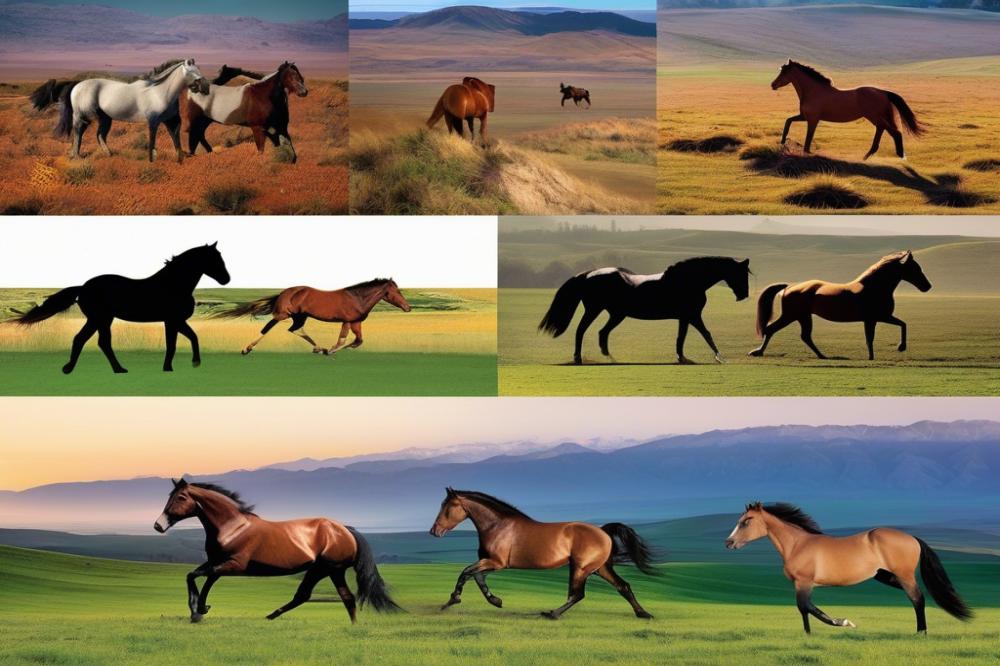Introduction
The journey of horses spans millennia, capturing the imagination of many. From the wild, small creatures that roamed ancient plains to the majestic animals we know today, their story is one of adaptation and transformation. This evolution reveals much about human society, reflecting changes in culture, environment, and technology.
Fascinatingly, ancient horses, once small and agile, played a crucial role in the lives of early humans. Picture a time when these creatures were domesticated, serving as companions in the struggle for survival and as vital partners in labor. The symbiotic relationship between humans and equines flourished as humanity progressed. Every stride they took echoed melodies of ancient battles and noble quests.
Over time, selective breeding and environmental demands shaped their physical traits. Yet, this evolution is not merely about physicality. It encompasses bonds forged through shared experiences, adventures, and trials. Each era contributed to the intricate tapestry of horse characteristics, creating varieties tailor-made for different tasks, from plowing fields to racing down tracks.
Understanding horse evolution opens a window into our shared history. These animals have been more than mere tools; they have been partners in every sense of the word. Cultures across continents tell tales of their resilience, strength, and spirit. As we explore this evolutionary pathway, it becomes evident that horses mirror humanity’s own journey through time.
The significance of these creatures persists in modern society. While many now enjoy leisurely rides or competitions, the foundations laid by their ancestors are still apparent. Thus, the ongoing story of horses invites reflection on their past and admiration for their future.
horse evolution

Definition of Horse Evolution
The journey of horses over millions of years reflects a complex interplay of biology and environment. This transformation showcases how these majestic creatures adapted to their surroundings and the needs of humans. With each generation, subtle alterations emerged, marking pivotal changes that shaped the lineage of modern horses. Understanding this progression provides valuable insight into the way species evolve, offering a glimpse into their history and relationship with the world around them.
ancient horses and Their Characteristics
Long before the sleek steeds grazed pastures today, ancient horses roamed the Earth in various forms. One remarkable early ancestor, known as Hyracotherium, appeared around 55 million years ago. This pint-sized creature, resembling a small dog, had a flexible body and multiple toes, which provided it with agility in the forests of its time. Over epochs, horses evolved into larger beings; the development of longer legs helped them escape predators and traverse vast landscapes.
As ancient horses changed, so did their diet and habitat. Some adapted to open plains, their teeth evolving to chew tough grasses rather than softer leaves. Notable species like the Hipparion, with its three-toed foot structure and elongated limbs, thrived in more diverse environments. Such adaptations illustrate survival mechanisms necessitated by the challenges they faced. These earlier horses displayed a variety of coat colors, sizes, and social behaviors which echoed their unique lifestyles.
Comparison of Ancient Horses to Modern Horses
When one lays eyes on a contemporary horse, it’s easy to forget its ancient relatives. Modern horses, often bred for specific purposes, exhibit a vast range of sizes, from diminutive ponies to massive draft breeds. Instead of toes, today’s equines sport distinct single hooves that provide better speed and endurance over diverse terrain. Such differences highlight the significance of evolutionary pressures in shaping features most advantageous for survival and domestication.
Behaviorally, horses have also transformed. Their ancient predecessors may have lived in smaller, more transient groups for survival, whereas today’s horses thrive in herds, displaying complex social structures. Humans have played a substantial role in this evolution, selectively breeding animals for temperament, strength, and speed. Consequently, various breeds emerged, each reflecting a certain set of traits aligned with human needs and interests.
In essence, while the nuances of form and function have shifted significantly, the spirit of the horse remains timeless. Both ancient and modern horses share a deep-rooted connection to the land, embodying a narrative that stretches across millennia. It’s a story interwoven with endurance, adaptability, and the relentless passing of time, drawing us closer to understanding the significance of these noble creatures in our lives.
prehistoric horses

prehistoric horses roamed vast landscapes, embodying an era far removed from today’s domesticated equines. These ancestors of the modern horse, known as Equinae, existed in a variety of forms and sizes. They were more than just companions; they were pivotal players in their ecosystems. Many of these creatures sported short limbs and compact bodies, adaptations suited for the challenging conditions of their time. Imagine miniature ponies mingling with larger, more robust relatives. Each one had its own role in the primordial drama of survival.
Description of Prehistoric Horses
The early horses showcased remarkable diversity. One prominent species, the Hyracotherium, existed around 50 million years ago. They were relatively small, about the size of a dog, and possessed multiple toes—perfect traits for navigating a variety of landscapes. As the ages progressed, sizes increased, leading to larger species like the Merychippus, which appeared during the Miocene epoch. This creature had a single hoof, marking a shift towards modernity. It’s fascinating to think about how these gradual changes in structure mirrored the shifting world around them.
Key Species and Their Traits
Merychippus was not alone in this evolutionary journey. Some notable contemporaries include Hipparion, a species that thrived in the Pliocene. Adaptations in Hipparion included longer legs and improved speed, showcasing nature’s knack for innovation. With these longer legs, it dashed across open plains, evading predators and flourishing in an ever-changing habitat. Then there was the much later Equus, which emerged roughly 4 million years ago. This was the horse lineage that would ultimately lead to modern breeds. These animals were larger, with more refined features like elongated heads and crafted hooves that embodied the essence of equestrian excellence.
Pleistocene Horses and Their Adaptation
During the Pleistocene epoch, horses faced challenges that demanded drastic adaptations. Environmental shifts were intense. Woolly mammoths and saber-toothed cats populated the landscape, creating a fierce competition for survival. Notably, the standout species of this era was the spectacular Equus ferus, the wild horse. These creatures adapted to various climates. Some developed thicker coats, whereas others became adept at rapid movement across diverse terrains. Their significance cannot be understated—these formidable animals were not mere inhabitants but vital components of their ecological communities.
It’s compelling to ponder how these ancient horses influenced human progress. They were the embodiment of raw power, agility, and grace. As early humans began to interact with these magnificent beings, the stage was set for a new chapter in history. These prehistoric animals paved the way for the domestication of horses, forever altering the trajectory of human civilization.
The Process of Domestication

Discovery and Timing of Horse Domestication
The domestication of horses is shrouded in mystery. Historians suggest that this remarkable event took place around 3500 to 3000 BCE on the vast steppes of Central Asia. Early humans observed wild horses, drawn to their strength and grace. Initially, these animals were likely hunted for sustenance. Over time, a transformative leap occurred. The shift from predator to partner marked a pivotal moment. Closer interactions led to the gradual process of training and taming. People began selectively breeding for traits that suited their needs, creating a bond that intertwined human and equine destinies.
Impact on Human Societies
The significance of horse domestication cannot be overstated. Societies underwent seismic shifts as these majestic animals integrated into daily life. Communities that embraced equine companions found themselves with enhanced mobility. Borders expanded. Trade flourished as horse-drawn carts rushed between towns and cities, transporting goods at unprecedented speeds. Furthermore, horses played essential roles in warfare. Warriors mounted their trusty steeds, leading to the rise of cavalry forces that altered the dynamics of ancient battles. Tales of valiant riders and their steeds echo throughout history, showcasing a connection that spans generations.
Role in Transportation and Agriculture
Transportation transformed dramatically with the introduction of horses. No longer were people bound to their feet for travel. Caravans thrived, enabling the exchange of culture and resources across great distances. As riders took to the trails, vast networks of trade routes emerged, linking distant lands in ways previously unimaginable. Simultaneously, the agricultural landscape evolved. Horses worked tirelessly in fields, pulling plows and harrows. This labor revolutionized farming, increasing crop yields and enabling larger-scale cultivation. The horse became a linchpin in the progression of agrarian societies, making it possible to feed growing populations. With each trotting hoof, civilization advanced, carving a path for future innovations.
Equestrian Culture Through Ages
Development of equestrian practices
Throughout history, horses have been instrumental in shaping societies. The ancient nomads relied on equines for transport, food, and companionship. As civilizations flourished, so did the methods of horse handling and training. Early riders learned to master techniques that emphasized communication and harmony between horse and rider. Over centuries, these practices evolved, influenced by geography, culture, and necessity.
In medieval Europe, the emphasis shifted as knights began to use horses for warfare. These majestic creatures became symbols of power, adorned in elaborate armor. Riding styles were refined to reflect status and skill. Meanwhile, in Asia, the development of the stirrup revolutionized riding, allowing for greater stability and control. From chaotic skirmishes to elegant dressage, the practices transformed to reflect the times and needs of society.
Influence on art and literature
Equestrianism has greatly influenced art and literature throughout history. Sculptors captured the sinewy grace of horses in marble and bronze, immortalizing their beauty. From ancient cave paintings to Renaissance masterpieces, the horse has captured the imagination of artists and audiences alike. They didn’t just represent animals; they embodied ideals of strength and freedom.
Literature, too, has not shied away from the majestic creature. Stories often intertwine human and equine experiences, depicting loyal companions navigating through trials together. One can recall the powerful imagery of horses galloping through epic tales, symbolizing both adventure and the passage of time.
Modern equestrian culture and sports
Today, equestrian culture embraces a fascinating array of activities. From competitive events like show jumping and dressage to leisure riding in picturesque countryside, the relationship between human and horse has diversified. Various disciplines cater to different interests, each with its own set of rules and traditions.
In recent years, horse sports have attracted diverse participants. Individuals from all walks of life engage in riding, some seeking thrills, others pursuing relaxation. Clubs and organizations foster community and camaraderie, allowing riders to bond over their shared passion. How many people can claim they’ve experienced the gentle rhythm of a horse beneath them while forging connections with nature?
Humorous anecdotes often arise in equestrian circles. Stories of mishaps, like the unplanned dismount, are passed around, bringing laughter to the shared experience. Ultimately, horses have transitioned from essential work companions to beloved athletes and friends, reflecting the evolution of equestrian culture into a multifaceted lifestyle enjoyed by many today.
Modern Horse Breeds
Diversity of Modern Horse Breeds
In today’s world, horse breeds present a fascinating tapestry of colors, sizes, and temperaments. From the majestic Clydesdale with its powerful frame to the spirited Arabian known for endurance, each breed embodies traits shaped by geography and purpose. Breeders have meticulously crafted these animals over centuries, accommodating a variety of human needs. Imagine strolling through a horse show where sleek Thoroughbreds gracefully dart across the field, while gentle Fjords munch hay in the corners. The sheer variety is astounding, and it only starts to scratch the surface of equine diversity. Every livestock breed offers something distinctive, making it easy to understand why horses are cherished companions and working partners.
Role of Selective Breeding
Selective breeding has played a pivotal role in the development of modern horse breeds. This practice, as old as the industry itself, has enhanced traits that humans value. Whether it’s speed, strength, or temperament, deliberate choices have sculpted equine characteristics. Breeders observe traits, selecting the best to create offspring with desired qualities. A wise breeder once remarked, “You’re only as good as your last foal,” highlighting the constant quest for improvement. This method allows for targeted results, producing animals that excel in specific activities. From dressage to rodeo, the ramifications of selective breeding are apparent in every discipline.
Differences in Function and Appearance
Functions among various breeds exhibit remarkable differences, driven largely by their original roles. Some types shine in racing, showcasing unparalleled speed. Others, bred for ranch work, demonstrate strength and agility in handling cattle. Appearance further varies; the stately posture of a Saddlebred contrasts starkly with the compact build of a Miniature Horse. Colors can range from pure white to deep chestnut, displaying a rainbow of options for enthusiasts. Take a moment to bask in the sight of a Tennessee Walking Horse, its smooth gait mesmerizing spectators. Internal traits often parallel these physical attributes; high-energy breeds may not suit every rider’s calm demeanor. Understanding these differences highlights the complexity and allure of modern equine breeds.
Horses in Agriculture
Historical Significance in Agricultural Practices
Horses have played an integral role in agriculture for centuries. Their power transformed farming from a laborious task to a more efficient endeavor. Before the advent of tractors, farmers depended heavily on these magnificent creatures to plow fields and transport goods. A horse could pull plows, harrows, and wagons, enabling a single farmer to accomplish what would take many men without them. This shift not only increased productivity but fundamentally changed the landscape of rural life. As communities grew, so did the reliance on equines for sustenance and commerce.
Use of Horses in Various Cultures
Around the world, different cultures embraced the horse’s capabilities for agricultural purposes. In Asia, horses are still used in certain rural areas for tilling land and carrying crops to market. Similarly, European farmers have a rich history of utilizing draft horses, ensuring a robust agricultural output for generations. The American Plains saw the horse acting as a vital ally for settlers, enabling them to cultivate vast stretches of the land. Meanwhile, in parts of Africa, the horse remains a symbol of status and strength, playing an essential role in subsistence farming. The adaptability of these animals to various climates and terrains has made them indispensable to human society.
Transition of Horses in Farming Techniques
Farming techniques have undergone a significant transformation over the years, much like the evolution of horses themselves. Initially, horses worked in tandem with oxen, sharing the heavy lifting tasks on farms. However, with the development of lighter plows and improved harnessing methods, horses became the preferred choice. Their agility and speed allowed farmers to cultivate land more effectively. Gradually, as mechanization took hold in the 20th century, horses began to fade from mainstream agriculture. Tractors replaced them, yet they still hold a niche in organic and sustainable farming methods. The nostalgia for horseback farming finds its way into modern practices, particularly among small-scale farmers who seek to connect with the land in a more traditional manner.
Cherishing the Legacy of Equines
A profound tale unfolds when we consider the journey of equines from their wild roots to their esteemed place in modern society. These remarkable animals have walked alongside humans for centuries, embodying resilience and adaptability. Each stride taken echoes a history rich with diverse interactions, whether in the fields of agriculture or the realms of sport. The timeline of these creatures tells a story that resonates with many cultures, demonstrating their significance beyond mere utility.
Transformation has been a defining characteristic of the equine lineage. From the small, forest-dwelling ancestors to the noble steeds of today, their physicality and temperament have shifted drastically. Evolution has not merely crafted a being suited for riding or labor; it has birthed companions who are intricately woven into the fabric of human experience. The bond formed between people and these animals continually evolves, manifesting in various roles such as therapy animals, competitive partners, and trusted friends.
In our exploration of ‘prehistoric horses’, we uncover how environment shaped them and their descendants. These early forms had to contend with harsh climates, forging a lineage of strength and endurance. Today’s breeds exhibit varying traits influenced by selective breeding practices, demonstrating both the ingenuity and the complexities of human intervention.
Equally vital is understanding how their physical anatomy has adapted through time. Insights from ‘equine history’ reveals the intricacies that allow for the agility and stamina we see today. Each horse, regardless of its unique lineage, carries within it a whisper of its ancestors, reminding us of the enduring legacy they uphold.
True appreciation for these magnificent creatures requires recognizing their journey and the roles they continue to fulfill in our lives. In contemplating their evolution, we find parallels in our own growth. A call to action resonates here: engage with the equestrian world, learn about these remarkable beings, and perhaps even form connections of your own. For those eager to delve deeper, signing up for our services opens doors to new discoveries and experiences in the captivating realm of horses. Join us on this journey by clicking here.



